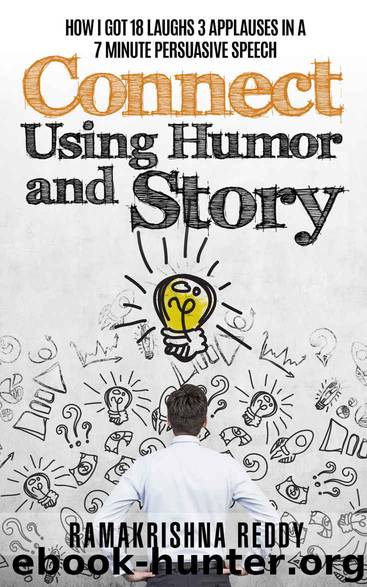Connect Using Humor and Story: How I Got 18 Laughs 3 Applauses in a 7 Minute Persuasive Speech by Ramakrishna Reddy

Author:Ramakrishna Reddy [Reddy, Ramakrishna]
Language: eng
Format: azw, mobi, epub
Publisher: PublicSpeakKing.com
Published: 2016-05-07T16:00:00+00:00
Dialogue can be used to convey the Core Message of your speech
Dialogue can be used as a punch line for your laugh lines
Another secret to quickly create humor is through Dialogue. You can set the right context to give the character the power to convey the emotions and intentions through dialogue. Done well, this is the point in time where the connection with audience will become strong.
Even off stage, you crack up because someone says something surprising. People are programmed to laugh this way. However, to be funny on stage, the premise has to be set clearly before you say the dialogue in your story.
For example, in the swimming story, when my dad was coaching me to swim, my thoughts were ‘should I really learn to swim from him’. However, to maintain the flow of the speech, I got creative and said it as a dialogue.
“He goes, ‘Do you want to learn swimming or not?’ I said, ‘that’s what I’m thinking’.”
The Dialogue, ‘that’s what I’m thinking’ is the punch line.
Here’s another example to create humor by using dialogue:
“We guys started discussing our ranks and Vivek said, ‘I wonder how these guys end up in top three ranks’. I said, ‘Vivek, even you can be in top three if you study harder’. And he goes, ‘you can’t even beat my rank. Just shut your mouth and leave‘.”
See if you can observe how the conflicting situation was crafted to be insulting to the Protagonist and still get away with the laugh. This explains the benign violation theory, which was introduced in Chapter 1. That theory is really helpful when designing dialogue for laugh lines. It will be funny only if any insult or harm to the character is benign, not malign. Dr. Peter McGraw & Joel Warner explains this concept in detail in the book ‘The Humor Code’. When I lack the time to test a laugh line, I use this same principle to gauge whether the laugh line might work or not. However, the best way to find if a laugh line works or not is to TEST it. Just deliver the laugh lines to a group of people at a dinner or over coffee and see how they respond. If you get positive response, note it down. This will really help you create some smart and crisp dialogues for your speech.
Monologue
Monologues in this context are the ‘actual’ thoughts that come to your mind during an experience. These thoughts can be used to create punch lines.
Monologue is a dialogue, which you speak to yourself. How do you express this in a speech? One way is to write the monologue in the same way you would write a line of a dialogue and add ‘was like’. So when you say, ‘was like’, it conveys intent, yet it does not mean you actually spoke those words. This works very well for first person. For example, “I was like ‘Really?’”.
However when you are creating monologues from second person perspective, then you can use ‘as if to say’.
Download
Connect Using Humor and Story: How I Got 18 Laughs 3 Applauses in a 7 Minute Persuasive Speech by Ramakrishna Reddy.mobi
Connect Using Humor and Story: How I Got 18 Laughs 3 Applauses in a 7 Minute Persuasive Speech by Ramakrishna Reddy.epub
This site does not store any files on its server. We only index and link to content provided by other sites. Please contact the content providers to delete copyright contents if any and email us, we'll remove relevant links or contents immediately.
The Art of Coaching Workbook by Elena Aguilar(51080)
Trainspotting by Irvine Welsh(21573)
Twilight of the Idols With the Antichrist and Ecce Homo by Friedrich Nietzsche(18570)
Fangirl by Rainbow Rowell(9179)
Periodization Training for Sports by Tudor Bompa(8214)
Change Your Questions, Change Your Life by Marilee Adams(7687)
This Is How You Lose Her by Junot Diaz(6835)
Asking the Right Questions: A Guide to Critical Thinking by M. Neil Browne & Stuart M. Keeley(5709)
Grit by Angela Duckworth(5557)
Red Sparrow by Jason Matthews(5428)
Paper Towns by Green John(5141)
Room 212 by Kate Stewart(5073)
Ken Follett - World without end by Ken Follett(4684)
Housekeeping by Marilynne Robinson(4396)
The Sports Rules Book by Human Kinetics(4344)
Double Down (Diary of a Wimpy Kid Book 11) by Jeff Kinney(4242)
Papillon (English) by Henri Charrière(4229)
The Motorcycle Diaries by Ernesto Che Guevara(4053)
Exercise Technique Manual for Resistance Training by National Strength & Conditioning Association(4023)
